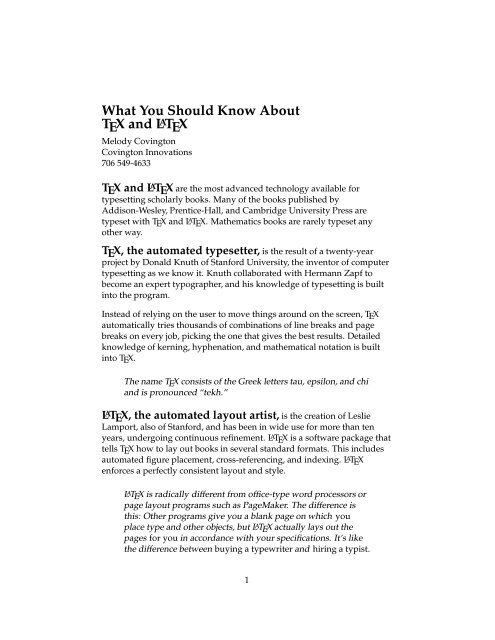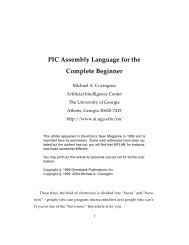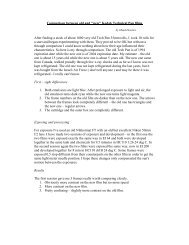What You Should Know About TEX and LATEX - Covington ...
What You Should Know About TEX and LATEX - Covington ...
What You Should Know About TEX and LATEX - Covington ...
Create successful ePaper yourself
Turn your PDF publications into a flip-book with our unique Google optimized e-Paper software.
<strong>What</strong> <strong>You</strong> <strong>Should</strong> <strong>Know</strong> <strong>About</strong><br />
<strong>TEX</strong> <strong>and</strong> L A <strong>TEX</strong><br />
Melody <strong>Covington</strong><br />
<strong>Covington</strong> Innovations<br />
706 549-4633<br />
<strong>TEX</strong> <strong>and</strong> L A <strong>TEX</strong> are the most advanced technology available for<br />
typesetting scholarly books. Many of the books published by<br />
Addison-Wesley, Prentice-Hall, <strong>and</strong> Cambridge University Press are<br />
typeset with <strong>TEX</strong> <strong>and</strong>L A <strong>TEX</strong>. Mathematics books are rarely typeset any<br />
other way.<br />
<strong>TEX</strong>, the automated typesetter, is the result of a twenty-year<br />
project by Donald Knuth of Stanford University, the inventor of computer<br />
typesetting as we know it. Knuth collaborated with Hermann Zapf to<br />
become an expert typographer, <strong>and</strong> his knowledge of typesetting is built<br />
into the program.<br />
Instead of relying on the user to move things around on the screen, <strong>TEX</strong><br />
automatically tries thous<strong>and</strong>s of combinations of line breaks <strong>and</strong> page<br />
breaks on every job, picking the one that gives the best results. Detailed<br />
knowledge of kerning, hyphenation, <strong>and</strong> mathematical notation is built<br />
into <strong>TEX</strong>.<br />
The name <strong>TEX</strong> consists of the Greek letters tau, epsilon, <strong>and</strong> chi<br />
<strong>and</strong> is pronounced “tekh.”<br />
L A <strong>TEX</strong>, the automated layout artist, is the creation of Leslie<br />
Lamport, also of Stanford, <strong>and</strong> has been in wide use for more than ten<br />
years, undergoing continuous refinement. L A <strong>TEX</strong> isasoftwarepackagethat<br />
tells <strong>TEX</strong> how to lay out books in several st<strong>and</strong>ard formats. This includes<br />
automated figure placement, cross-referencing, <strong>and</strong> indexing. L A <strong>TEX</strong><br />
enforces a perfectly consistent layout <strong>and</strong> style.<br />
L A <strong>TEX</strong> is radically different from office-type word processors or<br />
page layout programs such as PageMaker. The difference is<br />
this: Other programs give you a blank page on which you<br />
place type <strong>and</strong> other objects, but L A <strong>TEX</strong> actually lays out the<br />
pages for you in accordance with your specifications. It’s like<br />
the difference between buying a typewriter <strong>and</strong> hiring a typist.<br />
1
<strong>TEX</strong> <strong>and</strong> L A <strong>TEX</strong> are at their best when typesetting a book or series<br />
of books with a st<strong>and</strong>ard design. Many publishers have just two or three<br />
L A <strong>TEX</strong> book designs, which they use for all their books. Others make minor<br />
or major customizations for each book typeset.<br />
Implementing a new book design in L A <strong>TEX</strong> is a sizable amount of work<br />
because it involves modifying software. For this reason, I cannot supply<br />
sample pages of a book design “on spec.” Once the design is<br />
implemented, the computer does the rest, <strong>and</strong> relatively little human<br />
intervention is needed to typeset the entire book.<br />
<strong>You</strong> can save money by using a book design you have used before,<br />
or a minor modification of a st<strong>and</strong>ard one. Since L A <strong>TEX</strong> has considerable<br />
typographic expertise built in, you need not specify everything. Whenever<br />
you leave something unspecified, L A <strong>TEX</strong> knows how to conform to<br />
st<strong>and</strong>ard practice. <strong>You</strong> do not need to specify the exact appearance of<br />
indented <strong>and</strong> enumerated lists, footnotes, <strong>and</strong> the like; L A <strong>TEX</strong> has<br />
reasonable defaults built in.<br />
Indeed, it can be a mistake to specify too much. If you don’t specify the<br />
size of a table, L A <strong>TEX</strong> will automatically size it to fit its contents. If you start<br />
specifying all the column widths, you’re doing unnecessary work, <strong>and</strong><br />
you’ll prevent L A <strong>TEX</strong> from coming up with what might well have been a<br />
more pleasing layout.<br />
Authors often like to use L A <strong>TEX</strong> for books that contain mathematical<br />
formulas. If an author is preparing a manuscript with L A <strong>TEX</strong> please ask for<br />
my brochure of instructions to authors. They will save work for the<br />
author, editor, <strong>and</strong> typesetter.<br />
In the absence of the brochure, instruct authors to use L A <strong>TEX</strong>2.09or<br />
L A <strong>TEX</strong>2ε <strong>and</strong> use high-level comm<strong>and</strong>s such as chapter <strong>and</strong> section<br />
rather than working out layouts for themselves.<br />
Fonts available include all Adobe Type 1 fonts as well as <strong>TEX</strong>’s own<br />
built-in fonts. Particularly noteworthy is Computer Modern Roman, a<br />
favorite for computer program listings because it is narrower <strong>and</strong> more<br />
legible than Courier. It is available only with <strong>TEX</strong>.<br />
Accents for foreign languages <strong>and</strong> phonetic symbols are available.<br />
L A <strong>TEX</strong> files are of two kinds. The text of the book is a plain ASCII file<br />
with markup codes inserted, for example:<br />
2
\chapter{First Steps in Calculus}<br />
\section{Derivatives}<br />
The derivative of a function is its rate of change.<br />
For example, given the function $y = f(x)$, the<br />
derivative $dy/dx$ is the rate of change of $y$<br />
relative to $x$, or $\lim_{\Delta x \rightarrow 0}<br />
\Delta y$.<br />
Note that instead of typing a chapter or section heading, the author or<br />
typist uses the comm<strong>and</strong>s \chapter <strong>and</strong> \section. Likewise, instead of<br />
trying to reproduce mathematical formulas on the screen, the author types<br />
them in L A <strong>TEX</strong>’s special language, using comm<strong>and</strong>s such as \Delta.<br />
This method of typing has three advantages:<br />
• L A <strong>TEX</strong> files can be typed, viewed, <strong>and</strong> edited with any file editor or<br />
word processor.<br />
• <strong>You</strong> don’t have to worry about whether subtle details of typography<br />
are visible on the screen. Instead, you type L A <strong>TEX</strong> comm<strong>and</strong>s <strong>and</strong><br />
L A <strong>TEX</strong> will set exactly what you tell it to.<br />
• A completely separate file called a style sheet (actually a computer<br />
program) defines what the \chapter <strong>and</strong> \section comm<strong>and</strong>s, <strong>and</strong><br />
their kin, actually do. The typist does not have to worry about the<br />
physical layout or consistency of chapter or section headings on the<br />
screen.<br />
The third of these is the most important. The typist doesn’t have to worry<br />
about keeping style, margins, <strong>and</strong> layout consistent from one page or<br />
chapter to the next. In fact, the typist can’t set margins – that is left entirely<br />
to the style sheet! If you typeset ten books with the same style sheet, they<br />
are guaranteed to look the same.<br />
Figures are placed automatically. It is possible to tie figures to<br />
specific places in the text, but L A <strong>TEX</strong> also knows how to h<strong>and</strong>le “floats” —<br />
floating figures <strong>and</strong> tables that are placed where convenient, separated<br />
from text by a line or some blank space, as is st<strong>and</strong>ard practice in scholarly<br />
books.<br />
Figure numbering is done automatically, <strong>and</strong> in order to refer to them in<br />
the text, figures can be given names that will automatically be replaced by<br />
the correct numbers.<br />
3
L A <strong>TEX</strong> is portable. L A <strong>TEX</strong> input files <strong>and</strong> style sheets are identical, <strong>and</strong><br />
produce identical results, whether L A <strong>TEX</strong> is running on a PC, Macintosh,<br />
UNIX system, VAX, IBM mainframe, or something else.<br />
Usual practice is to deliver the results of the typesetting in the form of<br />
PostScript files. These files are also completely portable; they contain all<br />
needed fonts within them <strong>and</strong> will produce identical printouts on any<br />
PostScript printer or phototypesetter, regardless of the type of computer to<br />
which it is attached.<br />
4





